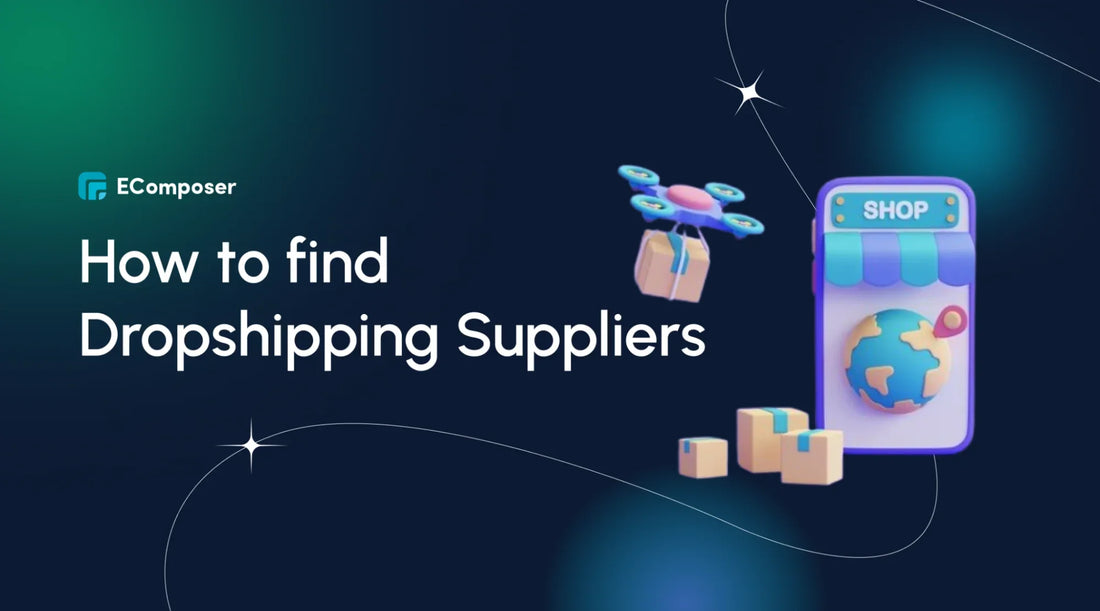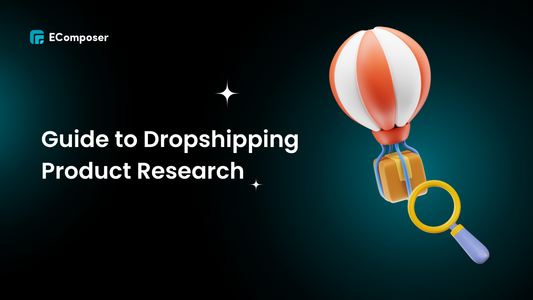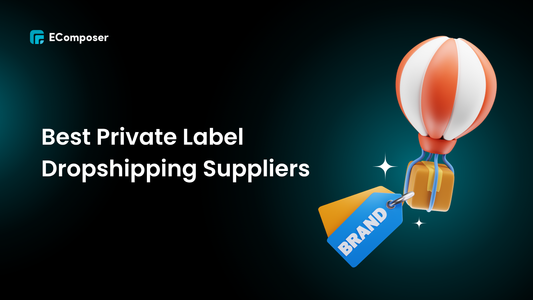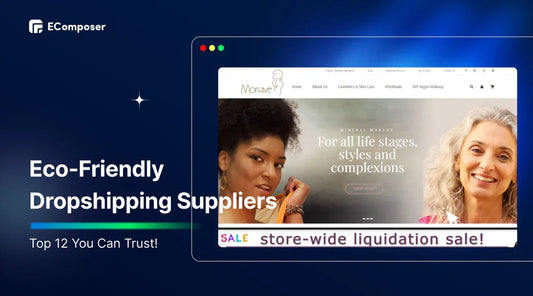How To Find A Dropshipping Supplier (2025 Comprehensive Guide)

Table Of Contents
Understand Your Niche & Products

(image source: EComposer's Template)
Dropshipping is a retail fulfillment method where the store owner doesn't keep products in stock. Instead, when a customer orders, the store owner purchases the item from a third-party supplier, who then ships it directly to the customer. Before searching for a dropshipping supplier, you must first understand your niche and the products you'll be selling. Here’s how to get started:
- Define Your Niche: Identify a specific market segment or industry that interests you and where there is demand. Whether it’s eco-friendly gadgets, pet accessories, or fitness apparel, knowing your niche helps tailor your product selection and marketing strategies. Choose one dropshipping business idea that fit your goal.
- Research Market Trends: Use tools like Google Trends, social media insights, and industry reports to understand your niche's current trends and consumer preferences. This research will guide you in selecting popular and profitable products.
- Analyze Competitors: Look at successful competitors in your niche. What products are they offering? What suppliers are they using? This can provide insights into what works and help you identify potential gaps in the market.
- Select Products Carefully: Choose products that fit your niche and balance demand and profitability well. Consider factors like product size, shipping costs, and potential profit margins.
Read more:
By thoroughly understanding your niche and carefully selecting your products, you’ll be better positioned to find a dropshipping supplier who meets your specific needs and helps you stand out in the market.
Types of Dropshipping Suppliers
- Manufacturers: Directly sourcing from the producer.
- Wholesalers: Working with suppliers who sell in bulk.
- Marketplaces: Utilizing platforms like AliExpress, Oberlo, or SaleHoo.
- Print-on-Demand Suppliers: Briefly touch on POD options.
When finding a dropshipping supplier, it’s essential to understand the different types available, each offering unique benefits and considerations. Here’s a breakdown of the main types of dropshipping suppliers:
Manufacturers
- What They Offer: Manufacturers are the original creators of products. They produce goods in large quantities and can offer these products at lower prices than other sources.
- Pros:
- Competitive Pricing: By cutting out the middleman, manufacturers often offer the lowest prices.
- Customization Options: Many manufacturers provide opportunities for custom branding and modifications.
- Quality Control: Directly working with manufacturers can improve quality assurance and consistency.
- Cons:
- Higher Minimum Order Quantities: Manufacturers may require larger order volumes, which can be challenging for new or small businesses.
- Complex Communication: Dealing with manufacturers often involves more complex negotiations and logistics.
- Best For: Businesses looking to establish a unique product line or those with sufficient capital to meet minimum order requirements.
Wholesalers
- What They Offer: Wholesalers buy products in bulk from manufacturers or distributors and sell them to retailers. They act as intermediaries between the manufacturer and the retailer.
- Pros:
- Wide Product Range: Wholesalers typically offer various products from various manufacturers.
- Established Logistics: Many wholesalers have efficient systems in place for order fulfillment and customer service.
- Lower Prices: Although not as low as direct manufacturer prices, wholesale prices are generally better than retail.
- Cons:
- Minimum Order Requirements: Wholesalers may have minimum order quantities, which can be a barrier for small businesses.
- Less Customization: Customization options are usually limited compared to working directly with manufacturers.
- Best For: Retailers seeking diverse products with reliable logistics and customer service.
Marketplaces
- What They Offer: Marketplaces like AliExpress, Oberlo, and SaleHoo connect retailers with various suppliers and offer a wide range of products from around the world.
- Pros:
- Ease of Use: These platforms are designed to be user-friendly, making it easy to find and start working with suppliers.
- Integration Tools: Many marketplaces offer automated order processing and inventory management tools.
- Variety: A vast selection of products across multiple categories.
- Cons:
- Variable Quality: The quality of products and reliability of suppliers can vary, requiring careful vetting and testing.
- Higher Competition: Since many retailers use the same suppliers, standing out in a crowded market can be challenging.
- Best For: New entrepreneurs or those looking to test different products without committing to large orders.
Print-on-Demand (POD) Suppliers
- What They Offer: Print-on-demand suppliers specialize in custom printing products like t-shirts, mugs, and phone cases. These services print and ship products only when an order is placed.
- Pros:
- No Inventory Required: No need to hold stock, which reduces upfront costs and financial risk.
- Customizable Products: Allows easy personalization and customization of products, which can appeal to niche markets.
- Scalability: Easily scale your business without worrying about production logistics.
- Cons:
- Higher Costs: Per-unit costs are generally higher than bulk purchasing, impacting profit margins.
- Longer Fulfillment Times: Customization and printing can lead to longer shipping than pre-made products.
- Best For: Businesses focusing on personalized or unique products where customization adds significant value.
Understanding these types of dropshipping suppliers will help you make informed decisions, ensuring you choose the right partner to support your business goals and operational needs.
How to find a dropshipping supplier

Finding a dropshipping supplier can be critical in establishing your eCommerce business. Selecting the right supplier can impact product quality, shipping times, and overall customer satisfaction. Here’s how to effectively search for and choose the right supplier:
Things need to be considered when choosing a dropshipping supplier
Several important factors should be considered when selecting a dropshipping supplier. These considerations will help you choose a supplier who aligns with your business goals and meets your operational needs.
- Product Quality: One of the most important factors is the quality of the products. Poor-quality items can lead to negative reviews and high return rates. Always check product samples before committing to a supplier.
- Shipping Times: Fast and reliable shipping is crucial for customer satisfaction. Ensure the supplier can deliver products within reasonable timeframes, especially if you're targeting specific regions (e.g., the US or Europe).
- Shipping Costs: Look for suppliers who offer competitive shipping rates, as high costs can deter customers. Some suppliers may offer free shipping options, while others may charge by location or product type.
- Minimum Order Quantity (MOQ): Check whether the supplier requires a minimum order. This is important if you plan to sell in smaller volumes or test products.
- Return Policies: Ensure the supplier has a transparent and fair return policy. You want to ensure that you and your customers are protected in case of defective or unwanted products.
- Supplier Reputation: Research the supplier's reputation online, including reviews from other merchants. Look for suppliers with a history of reliability, good customer service, and positive feedback.
- Communication & Support: Good communication is key to a successful partnership. Ensure the supplier is responsive to inquiries and offers reliable support for any issues that may arise.
Evaluate Potential Suppliers

Before finalizing your choice, evaluate each supplier carefully by considering the following:
- Order Samples: Place test orders to experience the product quality, packaging, and shipping times firsthand. This lets you see the customer’s perspective and ensures that the supplier delivers as promised.
- Review Feedback and Ratings: Look for reviews from other business owners on platforms like Trustpilot, Alibaba, or eCommerce forums. These reviews can give you insights into the supplier’s reputation for reliability, communication, and product consistency.
- Check Payment Terms: Different suppliers have different payment structures. Some may require upfront payments, while others offer net terms, allowing you to pay after orders are fulfilled. Choose a supplier with payment terms that fit your cash flow.
- Monitor Customer Service: Evaluate how the supplier handles customer service inquiries. Test their response time and professionalism when dealing with questions, concerns, or potential issues.
- Negotiate Contracts and Terms: Once you’ve vetted your potential suppliers, negotiate contracts that clearly outline shipping fees, return policies, and other terms. This will help prevent misunderstandings and ensure that both parties are aligned.
Use Tools and Resources to Streamline Operations
To manage your dropshipping business efficiently, there are several tools and resources available to help streamline your supplier management:
- Supplier Databases: Tools like Oberlo and Spocket help you find suppliers and sync products to your store, making inventory management more straightforward.
- Inventory Management Systems: Platforms like Shopify offer built-in inventory tracking features that automatically update when products are sold or restocked, helping you avoid overselling.
- Automation Tools: Tools like Dropified or AutoDS can automate your dropshipping workflow, from ordering products to processing returns. This allows you to focus more on marketing and scaling your business.
Watch for Red Flags
It’s essential to look for potential red flags when selecting suppliers. Here are some warning signs to avoid:
- High Upfront Fees: Avoid suppliers that ask for large upfront payments before placing orders, as this can indicate a scam.
- Unclear or Nonexistent Return Policies: Ensure the supplier has clear return and refund policies to protect you in case of faulty or unsatisfactory products.
- Poor Communication: If a supplier needs to respond or provide more specific answers to your questions, this could be a sign of future issues with order management and reliability.
- Lack of Transparency: A reliable supplier should be open about where its products come from, its shipping processes, and its production capabilities. Lack of transparency may signal quality issues or untrustworthy practices.
Best dropshipping suppliers 2025
To get started, here are some of the best dropshipping suppliers for 2025, offering diverse products, reliable shipping, and trusted services:
1. AliExpress

A well-known marketplace offering millions of products from suppliers across the globe. It's user-friendly and easily integrates with platforms like Shopify and Oberlo.
- Pros: Vast product selection, easy setup, low minimum orders.
- Cons: Inconsistent shipping times and product quality due to numerous suppliers.
2. SaleHoo

A directory of vetted suppliers offering wholesale and dropshipping options for various products. Ideal for those seeking reliable suppliers without exhaustive research.
- Pros: Verified suppliers, solid customer support, user-friendly.
- Cons: Membership fee required for access.
3. Spocket

Focused on US and European suppliers, Spocket offers faster shipping times than suppliers from Asia. It integrates seamlessly with Shopify and WooCommerce.
- Pros: Fast shipping, high-quality suppliers, premium products.
- Cons: Higher product prices than Asian suppliers.
4. Printful

A famous print-on-demand supplier allowing you to create custom designs for products like t-shirts, posters, and mugs. Ideal for personalized merchandise.
- Pros: No inventory, high-quality products, integration with multiple platforms.
- Cons: Product prices are relatively high, limiting profit margins.
5. Modalyst

It connects you to suppliers offering a mix of luxury, eco-friendly, and trending products. It works well with Shopify and offers automation for easy order fulfillment.
- Pros: High-quality product selection, US-based suppliers for fast shipping.
- Cons: Limited product categories compared to larger platforms.
6. CJDropshipping

Offers sourcing, product warehousing, and shipping services with competitive pricing. Known for efficient service and fast shipping times, especially to the US.
- Pros: Extensive product catalog, sourcing options, global warehouses.
- Cons: Some products may be more expensive than on AliExpress.
7. Wholesale2B

It provides access to millions of products from thousands of suppliers, all from one platform. It integrates with Shopify, Amazon, eBay, and other marketplaces.
- Pros: One-stop-shop for products, easy integration with major platforms.
- Cons: Subscription fee; some suppliers may have higher MOQs.
8. TeeLaunch

Another popular print-on-demand supplier focusing on apparel, accessories, and home decor. Specializes in custom products with excellent printing quality.
- Pros: Easy to use, low risk, high-quality printing.
- Cons: Limited to print-on-demand products, longer shipping times
Learn more here:
- Best Dropshipping suppliers for eCommerce Business
- Free Dropshipping suppliers in USA
- Home Decor Dropshipping suppliers in USA
Tips to work effectively with dropshipping suppliers

Establishing a robust and productive relationship with your dropshipping supplier is crucial for the success of your eCommerce business. The better your communication and collaboration, the smoother your operations will run.
1. Establish Clear Communication Channels
Effective communication is the foundation of any successful business relationship. By setting up clear communication channels, you and your supplier will be on the same page.
- Preferred Communication Method: Determine how you will communicate with your supplier (e.g., email, phone, messaging apps like WhatsApp or Skype). Regular check-ins help avoid misunderstandings and build trust.
- Response Time: Ensure your supplier can respond promptly, especially for time-sensitive matters such as order issues, product changes, or stock availability.
- Language Barriers: If you’re working with an international supplier, ensure that both parties can communicate effectively in a shared language. Miscommunications can lead to costly mistakes.
2. Set Clear Expectations
From the beginning, set clear expectations regarding product quality, shipping times, and customer service. Document these expectations to avoid disputes later.
- Order Processing Times: Clarify how long the supplier processes and ships orders. Faster processing means faster delivery to your customers, which can significantly impact customer satisfaction.
- Shipping Methods: Determine the supplier's shipping methods and whether they offer shipment tracking. Ensure these methods align with your customer's expectations.
- Return and Refund Policies: Agree on clear policies for handling returns, defective products, and refunds. This ensures that you and your customers are protected in case of any issues.
- Quality Control: Set expectations for consistent product quality and request product samples periodically to ensure consistency over time.
3. Build a Relationship of Trust
Developing trust with your supplier is essential to maintaining a long-term, successful partnership.
- Frequent Check-ins: Regularly check in with your supplier to discuss performance, challenges, or new opportunities. Being proactive can help avoid problems before they arise.
- Respect for Timelines: Respect your supplier’s timelines, especially during busy seasons. Timely payment of invoices and clear communication will strengthen the relationship.
- Collaborate on Improvements: Work with your supplier to address potential issues, such as delayed shipments or product defects. A cooperative approach is more effective than blame and criticism.
4. Use Automation Tools
Automation can help streamline your supplier relationship, reducing manual tasks and minimizing errors.
- Order Automation: Use dropshipping automation tools like Oberlo, Dropified, or AutoDS to automatically forward orders from your store to your supplier. This reduces the risk of manual entry errors and speeds up the fulfillment process.
- Inventory Management: Tools like Shopify or TradeGecko can automatically update your store's inventory levels based on your supplier’s stock. This prevents overselling and ensures accurate inventory tracking.
- Order Tracking Integration: Ensure that tracking information is automatically updated for your customers once your supplier ships an order. This keeps customers informed and reduces inquiries about order status.
5. Keep a Backup Supplier
Relying on a single supplier can be risky. If you have no alternatives, supply chain disruptions, stock shortages, or other unforeseen issues could jeopardize your business.
- Identify Backup Suppliers: Always have a backup supplier lined up if your primary supplier cannot fulfill orders. You can switch seamlessly in case of emergencies or during peak demand.
- Test Backup Supplier: Before relying on a backup supplier, run a few test orders to evaluate their product quality, shipping speed, and communication.
6. Monitor Supplier Performance Regularly
It's important to monitor your supplier’s performance over time to maintain a successful dropshipping operation.
- Key Performance Metrics: Monitor key metrics such as order accuracy, shipping speed, product quality, and customer satisfaction. Track how well the supplier meets your expectations.
- Regular Audits: Regularly audits product quality, packaging, and delivery times. If any areas need improvement, promptly address them with your supplier.
- Customer Feedback: Pay attention to customer feedback, as this can reveal issues with the supplier’s products or services that you might not have noticed.
7. Negotiate Favorable Terms
Once you’ve established a solid working relationship, consider negotiating better terms with your supplier to improve margins and efficiency.
- Bulk Discounts: If your business grows, negotiate for better pricing on higher order volumes. Many suppliers will offer discounts for bulk purchases.
- Shipping Rates: Negotiate lower shipping costs significantly if you’re scaling up. Ask your supplier to offer competitive rates that will help you stay profitable.
- Flexible Payment Terms: As you build trust, you can negotiate better payment terms, such as extending net payment terms to improve your cash flow.
8. Stay Updated on Industry Trends
Stay informed about trends in your niche and the dropshipping industry as a whole. New suppliers, shipping methods, and tools are constantly emerging, which can provide opportunities to enhance your business.
- Supplier Innovations: Regularly check in with your supplier to see if they have new products, services, or fulfillment options that could benefit your business.
- Market Changes: Monitor industry news and trends that might impact your business or your supplier relationship. For example, changes in trade regulations or shipping practices could affect your costs or delivery times.
Following these tips can build a strong, mutually beneficial relationship with your dropshipping supplier, ensuring smooth operations and a positive customer experience.
May you ịnterest
Final thought
Finding the right dropshipping supplier is essential for a successful eCommerce business. Focus on your niche, assess suppliers carefully, and prioritize product quality, shipping times, and clear communication. A strong supplier relationship helps you deliver a great customer experience and grow your business. You'll be ready to scale efficiently and stay competitive with the right supplier.





















0 comments